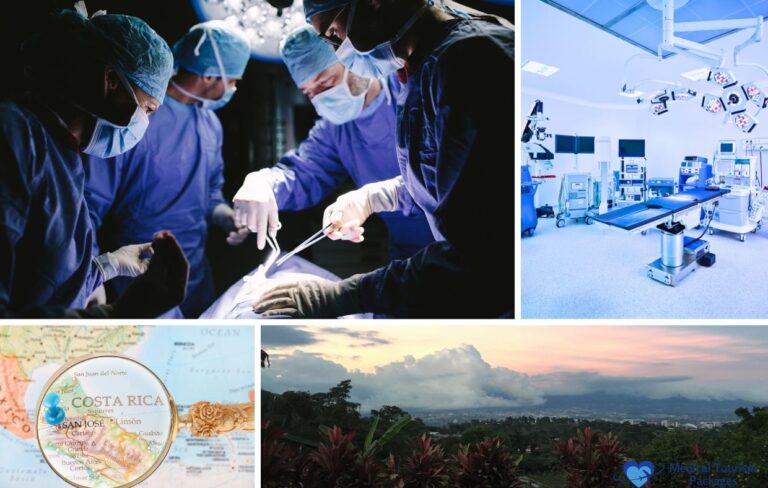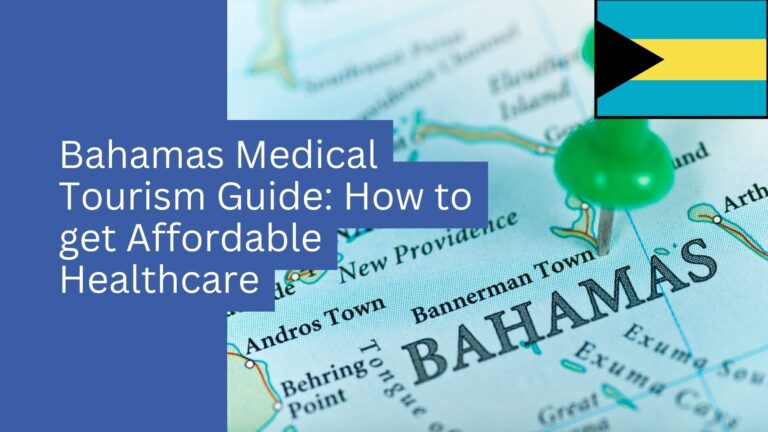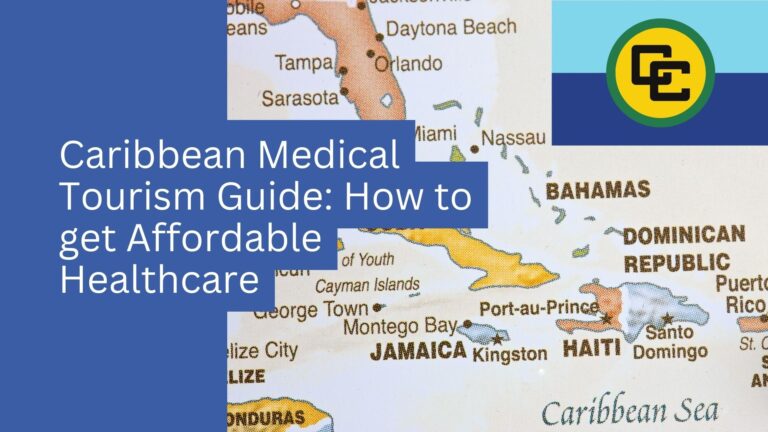Book Appointment Now

Medical Tourism vs. U.S. Healthcare: Cost Comparison 2025
More Americans than ever are booking flights to get their surgeries done overseas. Medical procedures abroad can cost 70-90% less than what you’d pay in the United States. A hip replacement that’ll set you back $40,000 in Chicago? You can get the same procedure in Panama for $8,000, and that includes the hospital stay.
The global medical tourism market hit $82.69 billion in 2024 and analysts expect it to reach $186.99 billion by 2029. Meanwhile, U.S. healthcare spending just crossed $4.9 trillion in 2023—that’s $13,432 per person. When a single dental implant costs $5,000 here and $800 in Costa Rica, patients are doing the math and buying plane tickets.
This report breaks down 2025 costs, compares value abroad versus the U.S., and addresses quality and safety concerns for prospective medical tourists.
Why U.S. Healthcare Costs Drive Medical Tourism Growth
U.S. healthcare costs have reached unprecedented levels, creating the primary reason Americans seek medical care abroad. We’re spending 17.6% of our entire GDP on healthcare, more than any other developed country. That percentage is expected to hit 19.7% by 2032, which means things aren’t getting better anytime soon.
The cost spiral that’s driving patients abroad
National health spending reached $4.9 trillion in 2023 and forecasts show it hitting $7.7 trillion by 2032. Hospitals alone account for 31% of all healthcare spending, and their operational costs keep climbing thanks to workforce shortages, supply chain problems, and inflation hitting everything from surgical gloves to MRI machines.
Labor costs at hospitals jumped to $839 billion in 2023. That’s a $42.5 billion increase since 2021. Drug expenses hit $115 billion last year, driven partly by new medications launching with median prices around $300,000 annually. When hospitals face 301 drug shortages per quarter on average, prices get pushed even higher.
Here’s what really gets patients frustrated: commercial health insurers denied 55.7% more claims in 2023 compared to previous years. Medicare pays hospitals only 82 cents for every dollar of actual care costs. These reimbursement shortfalls get passed along to patients through higher deductibles and co-pays.
The administrative burden alone costs hospitals about $20 billion annually just to appeal insurance denials. Add in cybersecurity costs (healthcare data breaches are the most expensive across all industries) and equipment expenses like $3.2 million cardiac MRI machines, and you start to see why a simple procedure can cost so much.
There’s another factor most people don’t consider: U.S. tariffs on imported medical supplies. Steep tariffs on syringes, surgical gloves, and diagnostic tools from major manufacturing countries drive up hospital procurement costs. These expenses get passed down to patients through higher bills and insurance premiums.
What patients face at the billing counter
Out-of-pocket spending hit $1,425 per person in 2022, with projections showing 3.5% annual growth through 2032. Even people with insurance struggle. High-deductible plans are common, and per-enrollee spending by private insurance grew 61.6% from 2008 to 2022.
Wait times add another layer of frustration. A hip replacement in Canada can take over six months to schedule, while a hip replacement in Colombia might be available within a week. This timing factor pushes even financially comfortable patients to consider overseas options.
Medical tourism as the practical alternative
Medical tourism means traveling to another country for medical care, and it’s become a practical solution for Americans dealing with domestic healthcare challenges. Patients often get faster access to procedures and sometimes treatments that aren’t readily available in the U.S.
Medical Tourism Cost Savings: Procedures and Destinations with Biggest Price Differences
Americans seeking medical care abroad typically save 25-90% compared to U.S. prices, but the actual savings depend heavily on which procedure you need and where you go. A hip replacement costing $39,299 in the U.S. might run $7,000-$15,000 in India or Colombia.
Some studies show average savings hitting 70% across various treatments and destinations. You need to factor in all costs, not just the procedure itself. Travel, accommodation, insurance, and contingency funds can add up quickly.
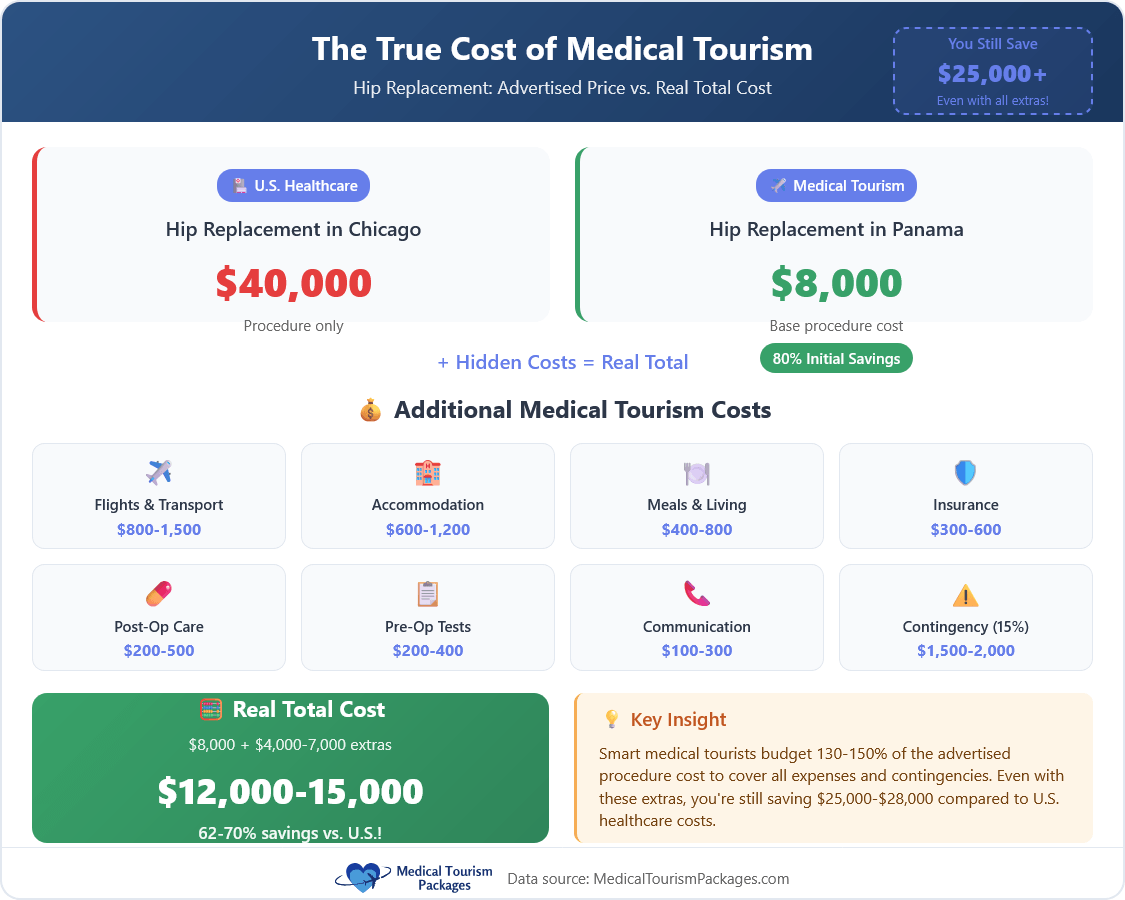
Procedures with the biggest price gaps
The cost differences between U.S. healthcare and the best medical tourism destinations are staggering, but they vary dramatically depending on what you need done. Cardiac procedures show some of the most extreme gaps. A heart bypass that costs $130,000 in the U.S. might run just $7,600 in India, representing a potential savings of over $120,000. But even “smaller” procedures add up quickly.
| Procedure | U.S. | India | Mexico | Costa Rica | Colombia | Panama | Thailand |
|---|---|---|---|---|---|---|---|
| Heart Bypass | $57,000-$200,000 | $5,200-$10,000 | $27,000 | $27,000 | $30,000 | $35,000-$37,000 | $15,000 |
| Heart Valve Replacement | ~$170,000 | $5,500 | $18,000 | $30,000 | — | — | $21,200 |
| Hip Replacement | $19,500-$40,000 | $7,000 | $8,000-$13,000 | $13,600 | $9,000-$12,000 | $8,000 | $7,900-$15,000 |
| Knee Replacement | $17,600-$50,000 | $6,200-$10,000 | $10,000-$15,000 | $12,000-$16,000 | $15,000 | $7,500-$20,000 | $10,000-$15,000 |
| Rhinoplasty | $6,000-$15,000 | $2,250 | $2,500-$4,500 | $3,900 | $2,000-$4,000 | $3,000-$5,500 | $2,400 |
| Breast Augmentation | $6,000-$12,000 | $2,750 | $3,000-$5,000 | $4,000 | $2,500-$4,500 | $3,500-$5,000 | $3,250 |
| Dental Implant (single) | $5,000-$6,000 | $400-$500 | ~$1,650 | $750-$850 | $600-$800 | $800-$1,200 | — |
These numbers demonstrate substantial savings potential. Take a knee replacement. If you’re looking at a $40,000 bill in the U.S., you could get the same procedure in India for $8,000, including the hospital stay. Even after factoring in flights, hotels, and recovery time, you’re still pocketing over $25,000.
Cosmetic surgery shows even more dramatic savings because U.S. insurance doesn’t cover these procedures. A facelift that might cost $25,000 in Beverly Hills could run $4,750 in Colombia, and many patients report identical or better results.
Dental work represents the biggest volume of medical tourism from the U.S., mainly because dental insurance provides limited coverage. A single dental implant costing $5,500 in the U.S. runs about $800 in Costa Rica. If you need multiple implants or full mouth reconstruction, the savings can easily hit $50,000 or more.
Fertility treatments offer another compelling case. IVF cycles in the U.S. average $12,000 just for the procedure, with medications adding another $4,000-$7,000. Panama offers complete IVF packages around $5,600, often including consultations and embryo storage that would cost extra in the U.S.
Why Latin America works for U.S. patients
Geography alone makes Latin American destinations appealing. You’re not dealing with 12-hour flights or major jet lag when you need to recover from surgery. These countries have built substantial medical infrastructure while maintaining cost advantages that can save U.S. patients $20,000-$100,000 depending on the procedure.
Mexico has become the go-to destination for dental tourism, with procedures often running one-third of U.S. prices. The proximity means you can drive across the border for treatment if you live in border states, eliminating flight costs entirely. Major cities like Tijuana, Mexicali, and Los Algodones have developed entire medical districts focused on serving American patients.
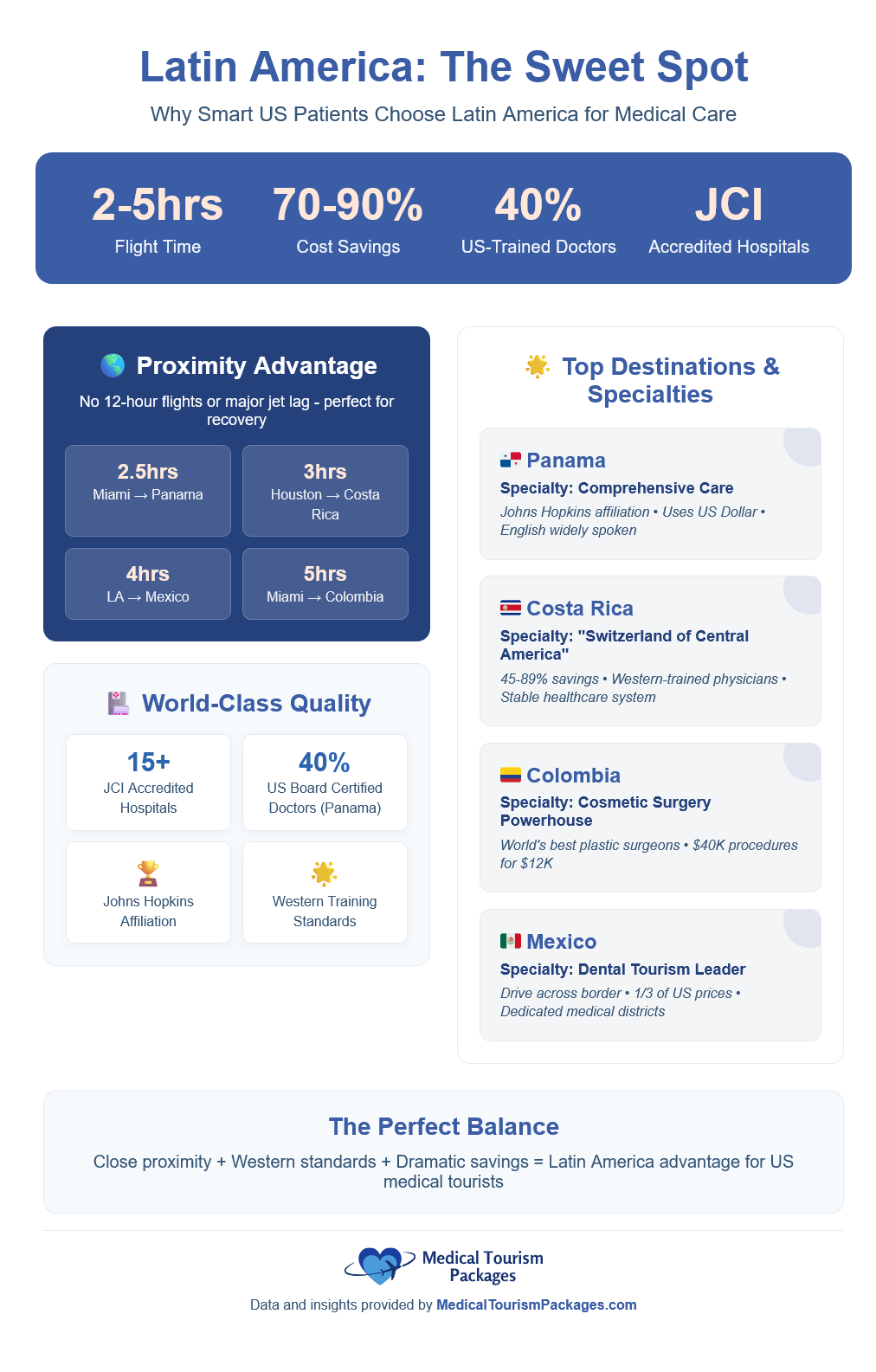
Costa Rica has earned a reputation as the “Switzerland of Central America” for healthcare quality. The country invested heavily in medical infrastructure and many physicians train in the U.S. before returning home. This combination of Western-trained doctors and lower operational costs creates the sweet spot where you get comparable care at 45-89% savings.
Colombia emerged as a cosmetic surgery powerhouse, particularly Medellín and Bogotá. The country produces some of the world’s most skilled plastic surgeons, and the cost difference is dramatic. A complete mommy makeover that might cost $40,000 in Miami runs about $12,000 in Medellín, including recovery accommodation.
Panama offers perhaps the most American-friendly experience, with 40% of doctors being U.S. board certified. Hospital Punta Pacifica’s affiliation with Johns Hopkins Medicine International means you’re getting Johns Hopkins protocols at Latin American prices. The country uses the U.S. dollar, eliminating currency exchange concerns, and English is widely spoken in medical facilities.
Additional costs to budget for
While procedure costs abroad are much lower, the ancillary expenses can catch people off guard. These additional costs are easy to overlook when you’re focused on the procedure price. Travel expenses vary wildly depending on where you’re going. Flights to Turkey might add $500-$1,500 per person; Mexico could be as low as $300-$800 if you’re on the West Coast.
Accommodation becomes more complex than a typical vacation because you need to factor in recovery time. You might book three nights but end up staying a week if healing takes longer than expected. Colombia offers budget options from $40-$100 per night, but you’ll want something comfortable and close to the hospital rather than the cheapest option available.
The insurance piece is where many people make costly mistakes. Your regular travel insurance probably won’t cover elective medical procedures abroad, and complications can get expensive fast. Specialized medical tourism insurance costs more upfront but can save you tens of thousands if something goes wrong.
Pre-surgery requirements can also add up. Some destinations require diagnostic tests that weren’t done at home, or your home doctor might want additional clearances before you travel. In South Korea, pre-surgery diagnostics for knee replacement can run $500-$1,000.
Smart budgeting means adding 15-20% to your total estimated costs as a contingency fund. Medical procedures don’t always go as scheduled, and having that buffer prevents scrambling for emergency funds if you need extra recovery time or additional medications.
The relationship between destination specialization and service levels also affects pricing. Thailand and Mexico are known for cosmetic and dental work, while India excels in cardiac and orthopedic surgeries. Within each destination, facilities range from budget-focused to premium, with prices reflecting the level of service and amenities.
Medical Tourism Quality vs. U.S. Healthcare: Safety and Standards Comparison
This question keeps most people awake at night when they’re considering medical tourism—whether the quality of care abroad matches what they’d receive in the U.S. Cost savings mean nothing if you’re compromising your health or safety. The real answer is: it depends on where you go and how thoroughly you research.
International accreditation standards
Joint Commission International (JCI) accreditation is the gold standard for international healthcare facilities. JCI puts hospitals through rigorous evaluation covering patient assessment, care delivery, surgical procedures, medication safety, infection control, and staff qualifications. It’s accredited by the International Society for Quality in Health Care and serves as a WHO Collaborating Centre for Patient Safety Solutions.
Many leading hospitals in popular medical tourism destinations have earned JCI accreditation:
Panama:
- Hospital Punta Pacifica (affiliated with Johns Hopkins Medicine International)
- San Fernando Hospital (first in Panama to get JCI accreditation)
Colombia:
- Hospital Internacional de Colombia in Bucaramanga (Cardiovascular Institute is JCI-accredited)
- Centro Médico Imbanaco in Cali (first in southwestern Colombia to get JCI accreditation)
- Fundación Cardioinfantil – LaCardio in Bogotá (received 4th consecutive JCI accreditation in April 2023)
- Hospital Pablo Tobón Uribe in Medellín (got 4th JCI Gold Seal in October 2024)
- Fundación Valle del Lili in Cali (achieved JCI accreditation in December 2024)
Costa Rica:
- Hospital CIMA San José in Escazú
- Clinica Biblica in San José
- Clinica Católica Hospital in Guadalupe
JCI accreditation is a strong indicator, but it evaluates the institution’s systems and processes, not individual physician competence. Even at accredited facilities, things like patient safety culture, particularly around error reporting and optimal staffing levels, can present ongoing challenges in some Latin American contexts.
Doctor qualifications and training
Many reputable international hospitals employ physicians who trained and got board certified in the U.S. or Europe. Panama reportedly has 40% of its doctors who are U.S. Board Certified. Doctors in Costa Rica and Colombia often pursue advanced studies in Western countries.
English proficiency among medical staff is generally high at facilities serving international patients. The presence of highly skilled, often Western-trained doctors, combined with lower systemic costs (reduced overhead, lower staff salaries, more affordable malpractice insurance), lets patients access comparable expertise at lower prices.
Hospital infrastructure and technology
The idea that lower costs mean outdated equipment is often wrong. Leading medical tourism hospitals frequently invest in state-of-the-art technology, sometimes sourcing equipment from the same manufacturers as U.S. hospitals. You’ll find advanced diagnostic imaging, specialized surgical units, and robotic surgery systems like the Mako robot for orthopedic procedures at HIC in Colombia or the Hugo™ RAS system at Pacifica Salud in Panama.
Patient safety risks to consider
Medical tourism isn’t risk-free. Here’s what can go wrong:
Varying standards: While top facilities meet international standards, infection control practices can vary significantly across different facilities and countries.
Infections: These are among the most common complications reported by medical tourists. You might face surgical site infections, blood-borne infections like Hepatitis B, Hepatitis C, and HIV, or infections resistant to drugs. Documented outbreaks, like fungal meningitis linked to procedures in Mexico, show these risks are real.
Standard surgical risks: Blood clots, adverse reactions to anesthesia, unsatisfactory results, wound healing problems, and in rare cases, death can occur abroad just like in the U.S.
Travel-related risks: Flying soon after surgery increases blood clot risk. Pressure changes can pose risks after certain surgeries. General travel safety and security matter too.
Counterfeit products: You might encounter counterfeit or substandard medications or medical devices that lack rigorous regulatory oversight.
Continuity of care problems: This is a big one. Getting detailed medical records from overseas facilities can be difficult, and U.S. physicians may hesitate to manage complications from procedures performed abroad, especially without complete information. This “care gap” can lead to treatment delays and potentially wipe out your initial savings if you need expensive emergency care or revision surgery in the U.S.
Legal recourse: If something goes wrong, your legal options in foreign countries may be more limited or complex compared to the U.S.
The CDC recommends discussing medical tourism plans thoroughly with your U.S. primary care doctor and the overseas provider well before travel. Check if your domestic health insurance covers any services abroad, understand the plan for handling complications, and don’t delay seeking medical care if issues arise.
Common Medical Tourism Cost and Quality Misconceptions
Despite growing popularity, medical tourism gets surrounded by myths about costs and quality that can mislead patients making important healthcare decisions.
Myth: Lower cost always means lower quality
This isn’t true. Many internationally accredited hospitals invest heavily in modern medical technology and recruit highly qualified professionals, many trained in Western countries. The significant cost savings often come from differences in economic structures: lower labor costs, reduced malpractice insurance, and lower operational overhead, rather than compromised care quality at reputable centers. JCI accreditation provides a tangible quality benchmark patients can verify.
Myth: It’s only for cosmetic surgery and non-essential procedures
Wrong again. While cosmetic surgery and dental treatments are popular, many people travel for serious, life-altering treatments including complex cardiac surgeries, cancer therapies, major orthopedic surgeries, advanced fertility treatments, and even organ transplants. For these patients, drivers include cost, access to specialized treatments not available at home, or bypassing long waiting lists for necessary medical interventions.
Myth: Language barriers make communication impossible
Reputable hospitals serving international patients typically employ multilingual staff or provide professional interpretation services. English is widely spoken in many leading medical tourism destinations, particularly within healthcare sectors serving international patients. However, patients should ask about language support and feel comfortable with communication arrangements before committing.
Myth: There’s no legal recourse if something goes wrong
While legal systems and malpractice processes differ from the U.S. and may be more complex, it’s wrong to say legal recourse doesn’t exist. Patients should research the destination country’s legal framework and understand their rights and complaint processes. Specialized medical tourism insurance policies are emerging that may offer coverage for complications or help with dispute resolution.
Myth: Medical tourism is unsafe or unregulated
Medical tourism is a legitimate industry in many countries that recognize its economic benefits and work to meet international healthcare standards. Patient safety largely depends on thorough research, choosing internationally accredited facilities like JCI-certified hospitals, and selecting qualified, experienced medical professionals. Risks exist in any medical procedure regardless of location, but they can be reduced through careful planning and informed choices.
Medical Tourism Decision Guide: Weighing Costs, Benefits, and Risks
Choosing medical tourism requires weighing anticipated financial benefits against potential drawbacks and the considerable effort involved in international medical travel planning.
Pros:
- Significant cost savings (30-90% for various procedures vs. U.S. prices)
- Access to quality care at JCI-accredited facilities with Western-trained professionals using modern technology
- Shorter wait times compared to potentially long lists in some Western healthcare systems
- Availability of specific treatments that may be more readily available abroad
- Opportunity to combine medical care with travel experience
Cons:
- Quality and safety variations—standards can differ significantly from the U.S., even with accreditation
- Risk of complications (surgical and travel-related) that can be challenging and costly to manage far from home
- Continuity of care issues—coordinating follow-up care in the U.S. can be difficult
- Limited legal recourse compared to the U.S.
- Significant travel and logistical effort required from patients
- Potential language and cultural barriers
- Hidden costs beyond initial procedure quotes
Whether medical tourism is “worth it” is highly individual, depending on your financial situation, risk tolerance, specific medical procedure needed (cost, complexity, urgency), and thoroughness of preparation.
Financial and logistics planning checklist
- Research potential destinations, hospitals, and surgeons thoroughly
- Verify hospital accreditations (JCI) and surgeon credentials/experience
- Look for multiple independent patient reviews
- Consult with your home doctor for opinion and advice
- Understand the specific procedure, expected outcomes, and potential risks
- Gather all relevant medical records, test results, prescriptions; arrange translation if needed
- Share complete medical history with chosen overseas provider
- Arrange pre-travel tele-consultations with overseas surgeon if possible
- Get any necessary pre-operative clearances or tests
- Get detailed, itemized quotes from chosen providers
- Create comprehensive budget including all costs plus 10-20% contingency fund
- Understand payment methods, deposits, and schedules
- Secure appropriate travel and medical tourism insurance
- Plan for currency exchange and potential fees
- Explore financing options if needed
- Ensure passport validity (at least 6 months) and get visas if required
- Book flights considering comfort for post-op return
- Arrange suitable accommodation prioritizing hospital proximity and recovery comfort
- Get “fit-to-fly” certificate if required
- Pack essential medications, comfortable clothing, medical supplies
- Plan local transportation and communication
- Understand post-operative care instructions and restrictions
- Arrange necessary follow-up appointments with overseas provider
- Plan continuity of care for return home; share all medical records with home physician
- Follow recovery protocols and activity limitations strictly
Potential hidden expenses to budget for:
Make sure you budget for additional expenses you might have. if you book with Medical Tourism Packages, you will get an Itemized budget with clarity on what will be included and what not, and how much you can expect from those extras.
| Category | Examples | Estimated Range |
|---|---|---|
| Travel & Transportation | Flights, visa fees, airport transfers, local transport | $300-$2,500+ per person |
| Accommodation | Hotel/rental for extended recovery period | $40-$300+ per night |
| Living Expenses | Meals, water, incidentals | $50-$150+ per day |
| Insurance | Medical tourism insurance, travel insurance | Variable, percentage of trip cost |
| Pre-Op Costs | Home consultations, diagnostic tests, vaccinations | $100-$1,000+ |
| Post-Op Care | Medications, supplies, follow-up appointments | $100-$700+ per month |
| Communication | International phone plans, local SIM cards | $50-$200 |
| Administrative | Record translation, currency exchange fees | Variable |
| Contingency | Additional treatment, extended stays, flight changes | 10-20% of total estimated costs |
Specialized insurance coverage can’t be overstated in importance. Standard travel or domestic health insurance often provides inadequate coverage for elective procedures abroad or complications. Insurance products specifically designed for medical tourists, covering medical complications and follow-up care in home countries, address significant financial risks.
Balancing treatment with travel
The appeal of combining medical treatment with vacation is strong marketing for many destinations, but the “vacation” aspect must support healing, not compete with it.
- Prioritize recovery over tourism activities
- Plan sufficient time at destination before and after procedure
- Follow surgeon’s post-op instructions strictly regarding activity, diet, wound care, medication
- Choose appropriate activities if engaging in any post-recovery tourism—opt for low-impact, restful activities
- The CDC specifically advises against strenuous activities, sunbathing, swimming, long tours, and alcohol during post-op periods
- Listen to your body and be ready to modify or cancel tourism plans
- Consider recovery environment—ideal setting promotes healing (quiet, comfortable, easy medical access if needed)
- Understand travel restrictions—airline guidelines for flying after surgery vary by procedure
Finding reputable providers overseas
The responsibility for vetting overseas providers rests with patients:
- Verify accreditation through JCI or other recognized international bodies directly through their websites
- Research specific surgeon qualifications, medical school, training, board certifications, years of experience, procedure specialization
- Look for independent patient testimonials and reviews on platforms, forums, advocacy groups
- For cosmetic procedures, request before-and-after photo portfolios
- Ask about experience with international patients and procedure volume
- Assess communication clarity, responsiveness, and professionalism during initial inquiries
- Use facilitators cautiously. Understand their vetting process, business model, potential conflicts of interest
- Consult your home country doctor for advice, important questions to ask, or potential referrals
Medical Tourism Market Trends and Cost Projections for 2025
The medical tourism industry continues evolving, influenced by healthcare technology advances, economic shifts, and changing patient cost expectations, with strong growth projected for 2025.
Market growth and evolving preferences
Various analyses project strong growth rates ranging from 12% to over 19% annually. Some forecasts suggest the market could reach approximately $187 billion by 2029-2034. The U.S. medical tourism market was valued around $3.87 billion in 2023, projected to reach $5.69 billion by 2029.
Growth factors include persistently high healthcare costs in developed nations (particularly the U.S.), increasing availability of high-quality medical services at lower prices in developing countries, shorter wait times abroad, growing global awareness facilitated by online platforms, aging global population with increasing healthcare needs, and government initiatives promoting healthcare services to international patients.
Patient preferences are evolving too. While cost remains primary, there’s increasing emphasis on care quality, patient experience, access to specialized treatments, and comprehensive care packages including travel and accommodation logistics. Integration of wellness services with medical treatments, creating “health and wellness tourism” experiences, is also growing.
Technology’s impact on medical tourism
Telemedicine allows patients to connect with overseas doctors before traveling, facilitating initial assessments, second opinions, and pre-operative planning. Post-op follow-up can also be supported through telehealth, helping bridge continuity of care gaps.
Digital health platforms and mobile applications make it easier for patients to research destinations and providers, compare costs, read reviews, schedule appointments, and manage medical records internationally.
Advanced medical technologies available in destination countries (robotic surgery, precision medicine, advanced diagnostics) significantly draw patients seeking latest treatment options.
AI and data analytics are being explored for improving diagnostic accuracy, personalizing treatment plans, and optimizing patient pathways in medical tourism.
Emerging destinations and specialties
While established destinations like Thailand, India, Mexico, and Costa Rica remain popular, new players are emerging and existing ones are diversifying specialty offerings.
Latin American countries like Colombia and Panama are strengthening positions in cosmetic, orthopedic, and cardiac care, leveraging U.S. proximity and improving infrastructure. European countries like Spain, Turkey, and Eastern European nations attract patients for various treatments. South Korea remains a leader in cosmetic surgery and advanced orthopedic procedures.
The trend toward “centers of excellence” focusing on specific complex treatments (oncology, advanced cardiology) will likely continue as hospitals invest in specialized expertise and technology to attract global patients.
Medical Tourism Cost FAQs: Planning, Savings, and Budget Questions
What procedures offer the best medical tourism cost savings abroad?
Procedures with the highest costs in the U.S.—such as cardiac surgeries (bypass, valve replacement), orthopedic surgeries (hip/knee replacement), extensive dental work, cosmetic surgery, and fertility treatments—tend to offer the greatest savings through medical tourism. Savings can range from 30% to 90%, depending on the procedure and destination, with countries like India, Thailand, Mexico, and Costa Rica offering the best value.
Are medical tourism savings worth the travel costs and planning effort?
The value of medical tourism depends on procedure cost and personal circumstances. For high-cost procedures over $50,000 in the U.S., savings often outweigh travel costs. However, minor treatments may not justify the travel effort. Factors like health status, risk tolerance, access to faster care, and unique technologies abroad also influence whether it’s worthwhile.
How can I find high-quality, accredited hospitals for medical tourism?
Look for hospitals accredited by JCI (Joint Commission International) and check affiliations with reputable Western institutions. Verify surgeon credentials, patient reviews, and use independent sources. Consult your doctor, consider medical tourism facilitators carefully, and review CDC guidelines. Don’t rely solely on a hospital’s website—research multiple quality indicators.
What hidden costs should I budget for in medical tourism?
Expect to spend 30–50% more than the procedure cost on hidden expenses. These include flights, accommodation, meals, insurance, post-op care, prescriptions, visa fees, communication tools, medical record transfers, and currency exchange. Set aside a 10–20% contingency fund for unexpected complications, extended recovery, or trip changes.
How should I prepare financially and logistically for medical tourism?
Start planning 3–6 months in advance. Get multiple quotes, create a detailed budget, and include a contingency fund. Clarify payment terms and research insurance options. Prepare medical records, schedule tele-consults, obtain necessary documents and medical clearances, and book travel/accommodation. Pack for recovery and arrange post-op care and communication logistics.
Can I combine medical tourism with vacation sightseeing?
Yes, but timing is key. Light sightseeing before treatment is fine if it doesn’t affect your health. Post-treatment tourism should be minimal and guided by your doctor. Avoid activities that hinder recovery, like drinking, intense sun exposure, or physical exertion. Focus on rest and healing; tourism should support—not delay—your recovery.
Medical tourism cost comparisons for 2025 reveal compelling alternatives to expensive U.S. healthcare, with potential savings of 30-90% on various medical procedures abroad. However, medical tourism decisions involve complex calculations of treatment costs, quality standards, safety risks, and personal priorities. While many international hospitals offer quality care through JCI accreditation and Western-trained physicians, patients must undertake rigorous research and preparation for successful medical tourism experiences. For many Americans facing prohibitive healthcare costs or limited treatment options at home, medical tourism will continue being a vital avenue for accessing affordable, quality medical care internationally.

